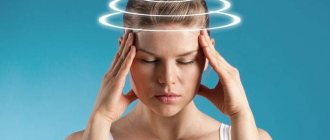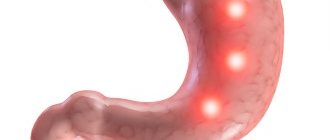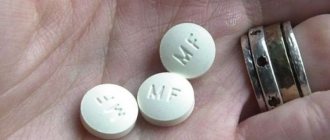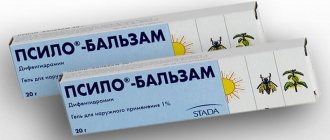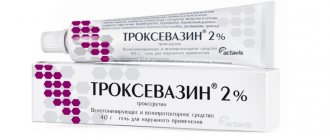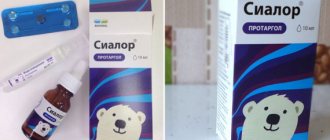Release form and composition
Available in the form of film-coated tablets: round, biconvex, dark pink (10 or 20 pieces in polypropylene tubes, 1 tube in a cardboard pack).
Active ingredients in 1 tablet:
- Propyphenazone – 200 mg;
- Caffeine – 80 mg;
- Camilofin chloride – 25 mg;
- Mecloxamine citrate – 20 mg;
- Ergotamine tartrate – 0.75 mg.
Excipients: tartaric acid, crospovidone, lactose monohydrate, talc, magnesium stearate, colloidal silicon dioxide, corn starch, polyacrylate dispersion, gelatin, macrogol 6000, polysorbate 80, titanium dioxide, carmellose sodium, red iron oxide dye.
Similar means
To replace Nomigren, its analogues are prescribed. The most popular of them:
Caffeamine. This medication contains ergotamine and caffeine. Used to eliminate headaches of vascular origin. Produced domestically.- Avamigran. A combined remedy for migraines, which contains almost all the active ingredients that are part of Nomigren. Its manufacturer is a German pharmaceutical company.
- MIG 400. An effective and quite expensive product from Berlin based on ibuprofen. It belongs to non-steroidal anti-inflammatory drugs. It is used to eliminate fever, relieve inflammation, and relieve pain, including migraines.
This or that remedy should be used after consultation with a doctor. He will help you choose the right dosage regimen depending on the patient’s characteristics.
Contraindications
Absolute:
- Thyrotoxicosis;
- Benign prostatic hyperplasia with urinary retention;
- Severe liver and/or renal failure;
- Sepsis;
- Obliterating diseases of peripheral vessels;
- Lactose intolerance, lactase deficiency, glucose-galactose malabsorption syndrome;
- Glaucoma;
- Organic cardiovascular diseases (including severe atherosclerosis, arterial hypertension, angina pectoris, frequent ventricular extrasystole, paroxysmal tachycardia, acute myocardial infarction);
- Pregnancy;
- Lactation;
- Age up to 15 years;
- Individual hypersensitivity to the components of the drug.
Relative:
- Migraine with focal neurological disorders;
- Sleep disorders;
- Anxiety disorders (agoraphobia, panic);
- Megacolon;
- Simultaneous use of glucocorticosteroids;
- Elderly age.
Nomigren
Nomigren is a combination drug that is used in the treatment of migraine headaches. Of all the diseases and pathological conditions, the most common among the world's population is headache. Migraine is a paroxysmal and, as a rule, one-sided headache, accompanied by vertigo, photophobia and the urge to vomit. The duration of a migraine attack varies from one minute to an hour or more of excruciating pain that originates in the front of the head and radiates to the face and neck, eye, and ear. In its development, migraine undergoes two phases: narrowing of the cranial arteries (prodromal period) and their expansion. Pain syndrome develops in response to ischemia and the onset of the inflammatory process. The development of migraine is inextricably linked with increased release in response to trigger factors of norepinephrine, histamine, serotonin, kinins, prostaglandins and a slow-reacting anaphylactic substance. Such a motley “cocktail” of biologically active substances leads to the consistent development of vasoconstriction and vasodilation, increased permeability of the walls of cerebral vessels, and local ischemia. Some food products (hard cheese, coffee, red wine, smoked meats), stress, depression, heavy physical activity, sudden changes in weather, hormonal imbalance, arterial hypertension, ENT pathology, etc. can act as migraine-provoking factors. Today, in the arsenal of clinicians there are drugs that specifically affect the key links in the origin and development of migraine and its individual manifestations. An example of such a drug is Nomigren. The therapeutic effect of the drug is determined by the totality of the pharmacological effects of its active ingredients. Kamilofin increases the lumen of cerebral vessels. It relieves spasm of cerebral vessels at the initial stage of the development of depression - in the phase of vasoconstriction, which is replaced by a phase of vasodilation.
At this phase, another active component of the drug, ergotamine, comes to the fore, which stimulates the smooth muscle fibers of the intra- and extracranial vessels, causing a decrease in their lumen. At the same time, blood circulation in the capillary bed is stimulated, vasogenic cerebral edema is reduced, and sensitivity to pain is reduced. Migraine manifestations are often accompanied by disorders of the gastrointestinal tract and impaired absorption of drugs in the small intestine, which reduces their bioavailability, and, consequently, their effectiveness. The caffeine contained in Nomigren stimulates the absorption of ergotamine from the gastrointestinal tract, thereby increasing its therapeutic effectiveness. Propyphenazone is an NSAID with a central analgesic effect. It inactivates the COX enzyme, which acts as a catalyst in the reactions of the formation of pro-inflammatory substances - arachidonic acid, prostaglandins, prostacyclins and thromboxanes, mediators of platelet aggregation and degranulation. In addition to this, propyphenazone interacts with the pain sensitivity centers of the hypothalamus, preventing the spread of pain impulses to the cerebral hemispheres. The analgesic effect of propyphenazone is also associated with its ability to activate the production of endorphins. Mecloxamine blocks histamine receptors, has a mild sedative effect, and suppresses the urge to vomit. It affects metabolic processes involving serotonin and histamine, inhibiting the release of these substances into the brain tissue, as a result of which the walls of cerebral vessels become less permeable. Nomigren in the amount of 1 tablet is taken at the first sign of pain. After half an hour, you should take the second tablet. The total daily dose should not exceed 4 tablets, and the weekly dose should not exceed 10.
Side effects
- Central nervous system: increased excitability and sleep disturbances; with prolonged use – addiction;
- Cardiovascular system: pain in the heart and muscles, increased blood pressure, changes in the electrocardiogram, transient tachycardia, paresthesia in the extremities, decreased pulsation in the extremities;
- Digestive system: nausea and/or vomiting; in rare cases - diarrhea;
- Other: weakness in legs; in rare cases - skin itching and peripheral edema.
Indications and restrictions
The drug is prescribed exclusively for the elimination of migraines. This is a type of headache caused by vascular disorders (for example, vegetative-vascular dystonia). In this case, the patient does not experience any visible disorders (craniocerebral injuries, hematomas, increased pressure in the skull, malignant neoplasms). That is, the diagnosis of migraine is made by excluding other diseases that may be accompanied by headaches.
Features of migraine
Migraine is characterized by throbbing pain that can occur constantly or periodically. This attack lasts from several minutes to several hours. In this case, the pain most often affects one side of the head (right or left). The drug Nomigren is intended specifically against the manifestations of migraine.
It is strictly forbidden to take the medicine if you have the following conditions:
- hypersensitivity to the components of the drug;
- lactose intolerance or deficiency, glucose-galactose malabsorption;
- severe pathologies of the cardiovascular system (cardiac ischemia, acute infarction, attacks of angina, tachycardia and extrasystole);
blood pressure is too high;- obliteration (blockage with connective tissue) of peripheral blood vessels;
- enlargement of the prostate gland not associated with cancer;
- intoxication with thyroid hormones due to their increased synthesis;
- functional disorders of the kidneys or liver;
- septic lesions.
There are also conditions for which this medicine should be used with caution. Among them:
- malformation of the colon, which is accompanied by its enlargement;
- elderly age;
- problems sleeping (insomnia);
- state of anxiety and panic;
- neurological disorders;
- simultaneous use of glucocorticosteroids.
It is not recommended to use the product to treat children under 15 years of age. It is unknown what negative reactions and consequences it can provoke in a small child and teenager.
During pregnancy, the medicine is not prescribed, since some of its components have a stimulating effect. This can lead to early miscarriage and premature birth later in pregnancy.
Certain substances (caffeine and ergotamine) can be absorbed into breast milk in large quantities and negatively affect the baby. Therefore, Nomigren should be avoided during lactation.
special instructions
It is important to strictly adhere to the recommended dosage regimen, because there is a risk of developing ergotism phenomena: cyanosis (especially of the fingers), pain in the legs, tingling sensation in the limbs, paresthesia, marked decrease in pulsation, loss of sensitivity, dizziness, stupor, convulsions, coma.
Patients taking the drug require periodic monitoring of their blood count.
If symptoms such as pain in the heart area, numbness in the tips of the toes or hands, or slowing or speeding up of the heart rate occur, stop taking the drug and consult a doctor immediately.
Nomigren may have a negative effect on the patient's psychophysical abilities, especially when taking drugs that depress the central nervous system or alcohol at the same time. For this reason, patients should refrain from driving vehicles and operating potentially dangerous machinery for 2-3 hours after taking the drug.
Nomigren is not intended for the prevention of migraine attacks!
Nomigren: instructions for use of tablets
Latin name: Nomigren ATC code: N02CA52 Active ingredient: kamilofin, caffeine, mecloxamine, propyphenazone, ergotamine
Manufacturer: Bosnalijek dd (BiH)
Dispensed from the pharmacy: by prescription Storage conditions: below 25°C Shelf life: 2 g.
Nomigren is a multicomponent drug with antimigraine, analgesic and antispasmodic effects. Indicated for treatment of:
- Acute attacks of migraine
- Migraine-like headaches caused by vasoconstriction.
Dosage form and composition of the drug
Medicine in the form of tablets under the shell. The components of the Nomigren tablet are:
- Active: 0.75 mg erogtamine tartrate, 0.2 g propyphenazone, 0.08 g caffeine, 0.025 g camilofin (as chloride), 0.02 g mecloxamine (as citrate)
- Auxiliary ingredients: corn starch, lactose, E 572, crospovidone, gelatin, Aerosil, talc, E 334, E 172 red, E 171, macrogol-6000, polysorbate-80, sodium KMC, polyacrylate dispersion.
Medicines in the form of round pills under a rich pink shell. The surfaces are convex. The product is packaged in PP tubes of 10 or 20 pieces. The package contains 1 container, accompanying description and manual.
Medicinal properties
Average price: (10 pcs.) – 514 rub.
The combined composition of the drug Nomigren provides several therapeutic effects: anti-migraine, analgesic, antispasmodic.
- Erogotamine is an ergot alkaloid that can partially block serotonin nerve endings. In addition, it has a strong ability to tone the vessels of the peripheral system, GM, which is very important for preventing the occurrence of migraines.
- Propyphenazone has a pronounced analgesic effect.
- Kamilofin relieves spasms, thereby immediately preventing the progression of migraines.
- Meclosxamine has anticholinergic, antihistamine, mild sedative and antiemetic properties.
After oral administration, the drug substances are absorbed from the gastrointestinal tract to a small extent. During the first passage through the liver, intensive metabolic processes occur.
The most active metabolites are excreted from the body by the intestines, slightly less than 4-5% are excreted unchanged in the urine. The half-life is about 20 hours.
Mode of application
According to the instructions for use of Nomigren, tablets are taken at the first sign of an attack.
In the beginning, it is recommended to take 1-2 pills. If after half an hour the patient’s condition has not improved, then take an additional 1-2 pieces. The daily maximum of drugs is no more than 4 tablets, the weekly maximum is no more than 10 tablets.
The drug is not intended for long-term treatment. If the patient is prescribed a long course of tablets, then after one week of taking the medication, a 3-4-day break should be taken.
During pregnancy and breastfeeding
The medicine should not be taken during breastfeeding, as the caffeine and ergotamine contained in the composition are excreted into milk, which increases the risk of harmful effects on the unborn child. During treatment with Nomigren, lactation should be discontinued.
Contraindications and precautions
Nomigren is prohibited for use when:
- Hypersensitivity to at least one of the components
- Organic pathologies of the cardiovascular system (including acute myocardial infarction, angina pectoris, hypertension, moderate and severe atherosclerosis, ventricular extrasystole)
- Obliterating diseases of the vessels of the lower extremities
- Benign pancreatic hyperplasia with concomitant difficulty urinating
- Severe liver and/or kidney dysfunction
- Hyperthyroidism
- Pregnancy, GW
- Sepsis
- Lactose intolerance by the body, congenital lactase deficiency or GG malabsorption syndrome
- Under 15 years of age.
Can be used with caution when:
- Somnological disorders
- Conditions with increased anxiety
- Old age
- GCS therapy
- Migraines with concomitant neurological pathologies
- Megacolon (enlarged colon).
special instructions
The active ingredients of Nomigren can influence the speed of psychomotor reactions and clarity of thinking. Therefore, it is necessary to take increased precautions when driving a car or other types of transport, complex mechanisms, as well as during any unsafe activities.
Cross-drug interactions
The use of the drug Nomigren should be carried out taking into account possible reactions with other drugs:
- When taken together, the severity of the effects of TCAs, amantadine, and quinidine increases.
- The components of Nomigren potentiate the effect of ethyl alcohol and sedative drugs.
- A-adrenergic stimulants, beta blockers, nicotine, when used together with Nomigren, increase the severity of its vasoconstrictor effect.
- It is extremely undesirable to combine drugs with medications that constrict blood vessels, since such combinations provoke life-threatening arterial hypertension.
- When combined with drugs from a group of serotonin receptor blockers, the threat of delayed vasospastic adverse reactions increases.
- The concentration of ergotamine increases after a simultaneous course of Nomigren with macrolide antibiotics.
Side effects and overdose
The body’s negative response manifests itself mainly with long-term use of large dosages of Nomigren:
- Immune system: urticaria, hyperemia of the dermis, mucous tissues of the eye, nose, pharynx. If these adverse reactions occur, the drug should be discontinued immediately. Taking Nomigren can also provoke agranulocytosis and anaphylactic shock (cold sweat, dizziness, pale skin, respiratory depression, heart rhythm disturbances, swelling of the face. The shock appears immediately or within an hour after administration. If signs of anaphylaxis appear, you should urgently call an ambulance, and Before her arrival, ensure the patient has a normal supply of air).
- NS: tingling, goosebumps, numbness, weakness, suppression of consciousness, dizziness, limited motor activity of joints, headaches, severe drowsiness, convulsions, visions.
- Organs of vision, hearing, breathing: accommodation disorder (front sight), ringing in the ears, vertigo, shortness of breath, fibrosis.
- CVS: cyanosis, cold legs and arms, weak pulse, myocardial ischemia, heart pain, hypertension, bradycardia or tachycardia, heart attack.
- Gastrointestinal tract: nausea, vomiting, epigastric pain, dry mouth, diarrhea.
- Skin and subcutaneous layers: swelling, itching, rash, hyperemia.
- Musculoskeletal system: pain in the back, arms, legs, joints, leg cramps, muscle weakness.
- Caffeine syndrome develops after regular intake of large doses of caffeine. Characterized by increased anxiety, sleep disorders, depression, shortness of breath. After an abrupt cessation of the intake of the substance into the body, the patient develops a withdrawal syndrome, which is manifested by inhibition of central nervous system reactions, rapid fatigue, muscle hypertonicity, rapid heartbeat, arrhythmia, and heaviness in the chest.
The use of a large number of Nomigren tablets causes an overload of the body with drug components, which is manifested by nausea, vomiting, general weakness, loss of sensitivity, ringing in the ears, cyanosis of the legs, fluctuations in blood pressure (increase or decrease), tachycardia, drowsiness, convulsive syndrome, increased anxiety.
Therapy
Cleansing the body of drug residues by washing (if no more than 4 hours have passed) and taking activated carbon. To eliminate the manifestations of intoxication, symptomatic therapy is prescribed.
Analogs
It is impossible to select analogues for Nomigren, since there are no substitutes for the composition of the active substances. To choose a medication with a similar effect, you need to contact your doctor.
Caffeamine
Tatchempreparations (RF)
Price: table (10 pcs.) – 180 rub.
A drug with an anti-migraine effect, which is provided by the active substances - caffeine and ergotamine.
Indications for use are arterial hypotension and migraine attacks. The drug is available in tablets.
It is recommended to take the drug at the initial signs of a developing migraine or headache, 1-2 tablets. After stopping the attack, you can take the medicine in the following days, 1 tablet. x 2-3 rubles/day You are allowed to take no more than 4 pieces per day.
The drug is not intended for a long course due to the possible development of ergotism. After taking it for a week, you must take a 3-4 day break.
Pros:
- Helps with migraines
- Fast acting
- Available remedy.
Flaws:
- Eliminates symptoms, but not the cause of pain.
Download instructions for use
Drug "Nomigren" Download instructions "Nomigren" 91 kb
Source: https://lekhar.ru/lekarstva/preparaty-dlja-nervnoj-sistemy/nomigren-instrukcija-po-primeneniju/
Drug interactions
- Tricyclic antidepressants, quinidine, amantadine: the effect of Nomigren is enhanced;
- Antibiotics of the macrolide group (for example, erythromycin): the concentration of ergotamine in the blood plasma increases;
- Ethanol and sedatives: their effect is enhanced;
- Serotonin agonists (for example, sumatriptan): the risk of developing prolonged vasospastic reactions increases;
- Vasoconstrictors: the likelihood of developing life-threatening arterial hypertension increases (such combinations are strictly contraindicated);
- Beta-blockers, alpha-blockers, nicotine: the vasoconstrictor effect of Nomigren is enhanced.
Directions for use and dosage
To achieve maximum effect during treatment, Nomigren is recommended to be taken at the very beginning of an attack. The initial dose should be no more than 2 tablets. If improvement is not observed within 2 hours, taking the tablets should be repeated.
Experts do not advise exceeding the maximum daily dose, which is 4 tablets. You should also not take more than 10 tablets per week.
According to the instructions, Nomigren is not intended for long-term use. After the patient has been treated for a week, it is recommended to take a break for several days.
In case of simultaneous use of the drug with other drugs, you need to know that:
- Amantadine, as well as tricyclic antidepressants, can enhance the effect of the drug. This list includes quinidine.
- Nomigren may enhance the effect of sedatives and ethanol.
- Beta-blockers and nicotine increase the vasoconstrictor effect of Nomigren. Vasoconstrictor drugs can lead to hypertension, which can be life-threatening.
In addition, the drug should not be taken as a prophylactic medication for migraines.
pharmachologic effect
The combined drug has anti-migraine, antispasmodic and analgesic effects.
- Ergotamine is an ergot alkaloid; is a partial agonist of serotonin receptors, non-selectively blocks 5-HT1A-1D receptors. Ergotamine is characterized by alpha-adrenergic blocking activity in combination with a pronounced direct vasoconstrictor effect on the smooth muscles of peripheral and cerebral vessels. In this regard, against the background of the action of ergotamine, the tonic effect on peripheral and cerebral vessels predominates, which has therapeutic significance in relieving migraine attacks.
- Propyphenazone has an analgesic effect.
- Caffeine accelerates the absorption of ergotamine and enhances its therapeutic effect. Caffeine also has a tonic effect on brain vessels.
- Kamilofin has an antispasmodic effect, eliminating the initial vasospasm in the prodromal phase of a migraine attack.
- Mecloxamine has anticholinergic, antihistamine, moderate sedative and antiemetic effects.

